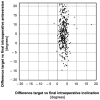Image-Less THA Cup Navigation in Clinical Routine Setup: Individual Adjustments, Accuracy, Precision, and Robustness
- PMID: 35744095
- PMCID: PMC9227241
- DOI: 10.3390/medicina58060832
Image-Less THA Cup Navigation in Clinical Routine Setup: Individual Adjustments, Accuracy, Precision, and Robustness
Abstract
Background and Objectives: Even after the ‘death’ of Lewinnek’s safe zone, the orientation of the prosthetic cup in total hip arthroplasty is crucial for success. Accurate cup placement can be achieved with surgical navigation systems. The literature lacks study cohorts with large numbers of hips because postoperative computer tomography is required for the reproducible evaluation of the acetabular component position. To overcome this limitation, we used a validated software program, HipMatch, to accurately assess the cup orientation based on an anterior-posterior pelvic X-ray. The aim of this study were to (1) determine the intraoperative ‘individual adjustment’ of the cup positioning compared to the widely suggested target values of 40° of inclination and 15° of anteversion, and evaluate the (2) ‘accuracy’, (3) ‘precision’, and (4) robustness, regarding systematic errors, of an image-free navigation system in routine clinical use. Material and Methods: We performed a retrospective, accuracy study in a single surgeon case series of 367 navigated primary total hip arthroplasties (PiGalileoTM, Smith+Nephew) through an anterolateral approach performed between January 2011 and August 2018. The individual adjustments were defined as the differences between the target cup orientation (40° of inclination, 15° of anteversion) and the intraoperative registration with the navigation software. The accuracy was the difference between the intraoperative captured cup orientation and the actual postoperative cup orientation determined by HipMatch. The precision was analyzed by the standard deviation of the difference between the intraoperative registered and the actual cup orientation. The outliers were detected using the Tukey method. Results: Compared to the target value (40° inclination, 15° anteversion), the individual adjustments showed that the cups are impacted in higher inclination (mean 3.2° ± 1.6°, range, (−2)−18°) and higher anteversion (mean 5.0° ± 7.0°, range, (−15)−23°) (p < 0.001). The accuracy of the navigated cup placement was −1.7° ± 3.0°, ((−15)−11°) for inclination, and −4.9° ± 6.2° ((−28)−18°) for anteversion (p < 0.001). Precision of the system was higher for inclination (standard deviation SD 3.0°) compared to anteversion (SD 6.2°) (p < 0.001). We found no difference in the prevalence of outliers for inclination (1.9% (7 out of 367)) compared to anteversion (1.63% (6 out of 367), p = 0.78). The Bland-Altman analysis showed that the differences between the intraoperatively captured final position and the postoperatively determined actual position were spread evenly and randomly for inclination and anteversion. Conclusion: The evaluation of an image-less navigation system in this large study cohort provides accurate and reliable intraoperative feedback. The accuracy and the precision were inferior compared to CT-based navigation systems particularly regarding the anteversion. However the assessed values are certainly within a clinically acceptable range. This use of image-less navigation offers an additional tool to address challenging hip prothesis in the context of the hip−spine relationship to achieve adequate placement of the acetabular components with a minimum of outliers.
Keywords: 2D/3D matching; accuracy; cup positioning; image–free navigated THA; intraoperative adjustments; precision.
Conflict of interest statement
The authors declare no conflict of interest.
Figures





References
-
- Zheng G., von Recum J., Nolte L.-P., Grützner P.A., Steppacher S.D., Franke J. Validation of a statistical shape model-based 2D/3D reconstruction method for determination of cup orientation after THA. Int. J. Comput. Assist. Radiol. Surg. 2011;7:225–231. doi: 10.1007/s11548-011-0644-7. - DOI - PubMed
MeSH terms
Grants and funding
LinkOut - more resources
Full Text Sources
Medical

